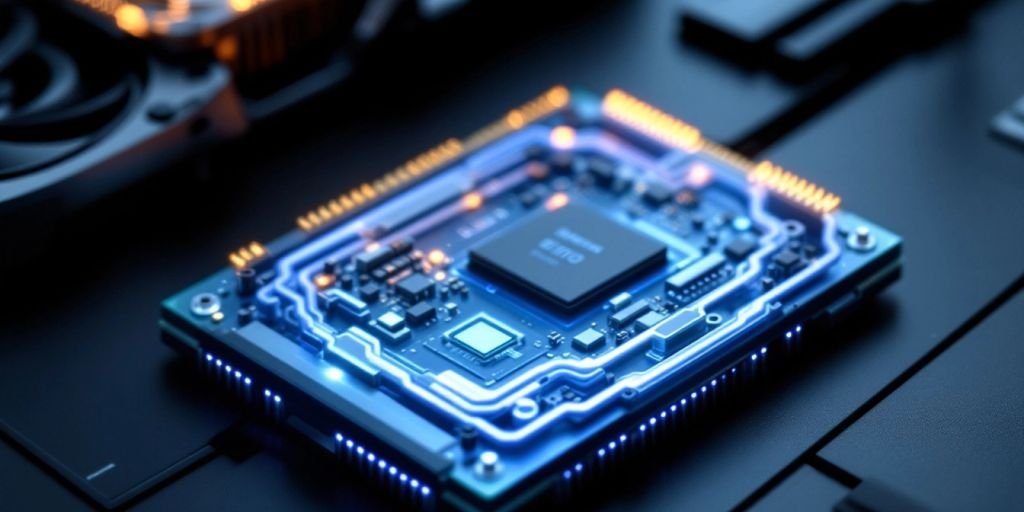In the competitive world of AI hardware, Cerebras and Nvidia have emerged as key players, each with unique offerings. The Cerebras CS-3, with its innovative Wafer-Scale Engine-3, claims to surpass Nvidia’s H100 GPU in performance. However, the newly introduced Blackwell B200 also poses a significant challenge. This article will explore the architectural differences, performance metrics, scalability, cost analysis, market implications, and technical challenges of these two powerful systems.
Key Takeaways
- Cerebras CS-3 features a massive Wafer-Scale Engine with 4 trillion transistors and 900,000 AI cores, making it a powerhouse for AI tasks.
- Nvidia’s B200, while powerful, offers less performance per watt compared to the CS-3, consuming more power for lower output.
- The CS-3’s design simplifies the deployment of large AI models, drastically reducing the programming required.
- Cost-wise, initial investments may be high for both systems, but the CS-3 could lead to lower operational costs over time due to its efficiency.
- Future innovations from both companies could reshape the AI landscape, with Cerebras focusing on scalability and Nvidia on enhancing GPU capabilities.
Architectural Differences Between Cerebras CS-3 and Nvidia B200

Wafer-Scale Engine vs. GPU Design
The Cerebras CS-3 employs a wafer-scale engine that integrates 4 trillion transistors across 900,000 AI cores. This design allows for a more compact and efficient architecture compared to Nvidia’s B200, which consists of two GPU dies with a total of 208 billion transistors. The CS-3’s architecture enables it to achieve higher performance in a smaller footprint.
Core Count and Transistor Density
| Feature | Cerebras CS-3 | Nvidia B200 |
|---|---|---|
| Total Transistors | 4 trillion | 208 billion |
| AI Cores | 900,000 | 2 (per die) |
| Performance (FLOPS) | 125 petaflops | 4.4 petaflops |
Cerebras’s CS-3 clearly outmatches the B200 in terms of core count and transistor density, making it a formidable contender in the AI hardware space.
Memory Architecture and Bandwidth
The CS-3 supports an impressive memory range from 12TB to 1.2PB, facilitating the training of large AI models. In contrast, the B200 offers 192GB of memory. The CS-3’s on-wafer fabric provides 27 petabytes per second of bandwidth, significantly surpassing the B200’s capabilities.
Power Consumption and Cooling Solutions
The CS-3 operates at a peak power consumption of 23kW, while the B200 consumes 14.3kW. Despite the higher power usage, the CS-3’s performance per watt is more efficient, providing a 2.2x improvement in performance per watt. This efficiency is crucial for data centre operators looking to manage operational costs effectively.
The architectural differences between these two systems highlight the unique strengths of the Cerebras CS-3, particularly in terms of scalability and efficiency. How do Cerebras chips compare to Blackwell? This question remains pivotal as the competition in AI hardware intensifies.
Performance Metrics: Cerebras CS-3 vs. Nvidia B200

Floating Point Operations Per Second (FLOPS)
The Cerebras CS-3 boasts an impressive 125 petaflops of AI compute, thanks to its 900,000 dedicated AI cores. In contrast, the Nvidia B200 delivers 4.4 petaflops per GPU, with a total of 36 petaflops when using eight GPUs in a DGX B200 server. This stark difference highlights the CS-3’s superior performance in training large AI models.
Training Large AI Models
When it comes to training large AI models, the performance metrics are crucial. The CS-3’s architecture allows it to handle models with trillions of parameters efficiently. Here are some key points:
- Higher core count: The CS-3 has 900,000 cores compared to the B200’s two GPU dies.
- Compact footprint: The CS-3 achieves its performance in a smaller space.
- Simplified programming: The CS-3’s design reduces complexity in programming compared to the B200.
Inference Capabilities
In terms of inference, the CS-3 also excels. Its on-wafer fabric provides 27 petabytes per second of bandwidth, significantly outperforming the B200. This allows for faster data processing and model inference, making it a strong contender in real-time applications.
Benchmark Comparisons
| Metric | Cerebras CS-3 | Nvidia B200 |
|---|---|---|
| FLOPS | 125 petaflops | 4.4 petaflops |
| Memory Capacity | Up to 1.2PB | 192GB |
| Power Consumption | 23kW | 14.3kW |
| Interconnect Bandwidth | 27PB/s | N/A |
The performance of the Cerebras CS-3 suggests that it may be a more efficient choice for organisations looking to train large AI models quickly and effectively. Cerebras Vs Nvidia: They claim its Wafer-Scale Engine-3 chip outperforms Nvidia’s H100 GPU but what about Blackwell? Understanding these metrics is essential for making informed decisions about AI hardware investments.
Scalability and Integration
Cluster Formation and Management
The ability to form clusters is crucial for scaling AI workloads. The Cerebras CS-3 allows for seamless integration of multiple units, enabling users to manage large-scale AI tasks efficiently. Key features include:
- Disaggregated memory architecture: This allows for the attachment of petabytes of memory to a single accelerator, making it easier to handle large models.
- On-wafer wiring: This technology connects hundreds of thousands of cores, enhancing performance without the need for complex external interconnects.
- Simplified deployment: Users can set up and manage clusters with minimal effort, reducing the time and resources needed for configuration.
Software Ecosystems
Both the CS-3 and Nvidia B200 support various software ecosystems, but the CS-3 is designed to simplify the programming model. This includes:
- Optimised libraries: Pre-built libraries that facilitate faster development and deployment of AI models.
- Compatibility with popular frameworks: The CS-3 supports frameworks like TensorFlow and PyTorch, making it easier for developers to transition.
- User-friendly interfaces: Simplified tools for monitoring and managing workloads, enhancing user experience.
Ease of Deployment
Deployment of AI systems can be complex, but the CS-3 aims to streamline this process. Key aspects include:
- Single unit operation: Unlike the B200, which requires multiple GPUs, the CS-3 can operate as a single unit, reducing setup time.
- Integrated cooling solutions: The design includes efficient cooling mechanisms, minimising the need for additional infrastructure.
- Rapid scaling: Users can quickly add more units to their setup without significant reconfiguration.
Future Scalability Prospects
Looking ahead, the scalability of the CS-3 appears promising. Factors contributing to this include:
- High interconnect bandwidth: The CS-3 provides 27 petabytes per second of bandwidth, far exceeding that of the B200.
- Support for larger models: The architecture is designed to accommodate future AI models that require extensive resources.
- Adaptability: The system can evolve with advancements in AI technology, ensuring longevity in a rapidly changing field.
The Cerebras CS-3 is not just a powerful tool; it is a game changer for organisations aiming to push the boundaries of AI capabilities. Its unique architecture and integration features make it a compelling choice for future AI developments.
In summary, the Cerebras CS-3 offers significant advantages in scalability and integration compared to the Nvidia B200, making it a strong contender for organisations looking to enhance their AI capabilities.
Cost Analysis and Total Cost of Ownership
Initial Acquisition Costs
The initial costs for acquiring the Cerebras CS-3 and Nvidia B200 can be significant. The Cerebras CS-3 is rumoured to be priced between $1 million and $2 million, while a fully populated Nvidia H100 server can cost around $300,000. This stark difference highlights the high upfront investment required for the Cerebras system, which is designed for specific high-performance tasks.
| System | Estimated Cost |
|---|---|
| Cerebras CS-3 | $1M – $2M |
| Nvidia H100 | ~$30,000 per unit |
| Fully Populated Nvidia Server | ~$300,000 |
Operational Costs
Operational costs are another critical factor in the total cost of ownership. These include:
- Energy consumption: The Cerebras system may require more energy due to its wafer-scale design.
- Cooling solutions: Advanced cooling systems, such as liquid cooling, can add to the operational expenses.
- Maintenance: Regular maintenance and potential upgrades can also impact long-term costs.
Energy Efficiency
Energy efficiency is a vital consideration. While the Cerebras CS-3 offers high performance, it may consume more power compared to traditional GPUs. This can lead to higher electricity bills, especially in large-scale deployments. Efficient cooling solutions are essential to manage this aspect effectively.
Return on Investment
The return on investment (ROI) for both systems can vary significantly based on usage. Factors influencing ROI include:
- Performance gains: The ability to train larger models faster can justify the higher costs.
- Market demand: As AI continues to grow, the demand for powerful hardware will likely increase.
- Long-term savings: Over time, the efficiency of the Cerebras system may lead to lower operational costs compared to multiple Nvidia units.
The wafer-scale integration from Cerebras is a novel approach that eliminates some of the handicaps that generic GPUs have and shows much promise.
In conclusion, while the initial costs of the Cerebras CS-3 are significantly higher, its potential for performance and efficiency may offer a compelling case for organisations focused on advanced AI applications.
Market Implications and Future Prospects
Impact on AI Research and Development
The emergence of the Cerebras CS-3 chip is set to challenge Nvidia’s dominance in the AI chip market. With Nvidia holding a significant 94% market share as of the end of 2023, the introduction of new competitors like Cerebras could lead to a more diverse landscape in AI hardware. This shift may encourage innovation and drive down costs, benefiting researchers and developers alike.
Competitive Landscape
The competition between Cerebras and Nvidia is intensifying, with several factors at play:
- Technological advancements: New architectures like the Wafer-Scale Engine are pushing the boundaries of performance.
- Market entry of new players: Companies such as Groq and MatX are also vying for market share, which could disrupt the status quo.
- Investment in AI: As the AI market continues to grow, more manufacturers are likely to invest in developing competitive products.
Potential Market Adoption
Despite the promising technology, many companies are still not yet making a profit. The high initial costs associated with these advanced chips may deter widespread adoption. However, as more enterprises recognise the potential benefits, we may see a gradual increase in market acceptance.
Future Innovations and Roadmaps
Looking ahead, the future of AI hardware appears bright. Key areas for innovation include:
- Improved energy efficiency: Reducing power consumption while maintaining performance.
- Enhanced software ecosystems: Developing robust software to support new hardware capabilities.
- Scalability solutions: Ensuring that new technologies can be integrated into existing infrastructures.
The AI chip market is evolving rapidly, and the competition between Cerebras and Nvidia will likely shape its future direction.
| Metric | Cerebras CS-3 | Nvidia H100 |
|---|---|---|
| Market Share | Emerging | 94% |
| Initial Cost | $1-2M/server | Varies |
| Performance (FLOPS) | High | High |
Technical Challenges and Limitations
Programming Complexity
The Cerebras CS-3 presents significant programming challenges. Unlike traditional GPUs, which have well-established programming frameworks, the CS-3 requires developers to adapt to its unique architecture. This can lead to:
- Increased learning curve for new users.
- Necessity for custom software solutions.
- Potential for longer development times.
Hardware Limitations
Despite its impressive capabilities, the CS-3 has certain hardware limitations:
- Scalability issues when integrating with existing systems.
- Dependence on specific cooling solutions due to high power consumption.
- Limited compatibility with some legacy software.
Compatibility Issues
The integration of the CS-3 into existing infrastructures can be problematic. Key concerns include:
- Difficulty in interfacing with traditional GPU setups.
- Need for specialised drivers and software updates.
- Potential for performance bottlenecks when used alongside older hardware.
The unique architecture of the CS-3, while powerful, can create barriers for widespread adoption in diverse computing environments.
Scalability Constraints
While the CS-3 is designed for large-scale AI tasks, it faces scalability constraints:
- Challenges in forming clusters with other systems.
- Limitations in expanding memory and processing power without significant investment.
- Inflexibility in adapting to rapidly changing AI workloads.
In summary, while the Cerebras CS-3 offers groundbreaking technology, it is essential to consider these technical challenges and limitations when evaluating its potential in the market.
Conclusion
In summary, the competition between Cerebras and Nvidia highlights significant advancements in AI hardware. The Cerebras CS-3, with its Wafer-Scale Engine-3, offers remarkable performance, boasting 125 petaflops of AI computing power, which far exceeds that of Nvidia’s H100 GPU. This performance is achieved with a simpler programming model and lower power consumption, making it an attractive option for organisations aiming to train large AI models efficiently. However, Nvidia’s upcoming Blackwell architecture, while not yet available, promises to enhance its capabilities significantly. As both companies continue to innovate, the landscape of AI hardware is set to evolve, presenting exciting opportunities and challenges for the future.
Frequently Asked Questions
What is the main difference between Cerebras CS-3 and Nvidia B200?
The Cerebras CS-3 uses a large wafer-scale chip with many AI cores, while the Nvidia B200 is made up of two GPU chips. This means the CS-3 can handle more tasks at once.
How does the performance of Cerebras CS-3 compare to Nvidia B200?
The CS-3 is faster, providing 125 petaflops of performance, compared to the B200’s 36 petaflops when using multiple GPUs.
What are the power requirements for these chips?
The CS-3 uses up to 23kW of power, while the B200 requires about 14.3kW. However, the CS-3 is more efficient in terms of performance per watt.
Can these chips be used for training large AI models?
Yes, both chips are designed for training large AI models, but the CS-3 is particularly good at this due to its architecture.
What are the costs associated with these systems?
The initial costs can vary, but generally, the CS-3 might be more expensive upfront, but it could save money in the long run due to its efficiency.
What future developments can we expect from Cerebras and Nvidia?
Cerebras plans to continue scaling its technology, while Nvidia is expected to enhance its GPU offerings to stay competitive.





